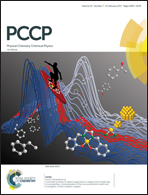Enhanced adsorption of CO2 at steps of ultrathin ZnO: the importance of Zn–O geometry and coordination†
Abstract
The interaction between CO2 and ultrathin ZnO supported on Au(111) has been studied using temperature programmed desorption (TPD) and density functional theory (DFT) calculations. We find that CO2 binds weakly on the planar ZnO bilayer and trilayer surfaces, desorbing at T = 130 K. CO2 binds more strongly at the steps formed between ZnO bilayers and trilayers, desorbing at T = 285–320 K depending upon the CO2 exposure. The adsorption energies determined from DFT calculations for CO2 on the ZnO planar surfaces and at the steps are ∼5.8 and 19.0 kcal mol−1, respectively, agreeing with the apparent activation energies of desorption (Ed) estimated based on the TPD peaks at the limit of low CO2 exposures (7.7 and 19.5 kcal mol−1, respectively). The DFT calculations further identify that the most stable adsorption configuration of CO2 at the steps of ultrathin ZnO is facilitated by the geometry and coordination of the Zn cations and O anions near the step region. Specifically, the enhanced adsorption takes place via bonding of both the C and O atoms of the CO2 molecule to the tri-fold coordinated O anions at the trilayer edge and to the neighboring Zn cations on the bilayer terrace, respectively, leading to CO2 bending and formation of a carbonate-like species.



 Please wait while we load your content...
Please wait while we load your content...